Tags
architecture, church of St Edward the Confessor, George Edmund Street, Greystones, Larner Sugden, Leek, Leek School of Embroidery, Nicholson Institute, Norman Shaw, oatcakes, ragged schools, River Churnet, silk mills, Staffordshire, stained glass, William Morris, William Sugden
The nearest town to where we usually stay in the Staffordshire Peaks is Leek. It is the principal town of the area and is known locally as ‘The Queen of the Moorlands’. It is not a large town; it is built on a hill and is contained in a large bend in the River Churnet. During the late 18th and early 19th centuries it changed from a quiet market town to a silk-weaving centre and a few large mills were built there. This industry has completely gone now but some of the old mills remain.
William Morris, the founder of the Arts and Crafts movement lived and worked in Leek from 1875 until 1878. He studied the art of dyeing there and it was Leek which provided his firm with silk.
R and I woke on the Saturday morning to hear the rain still falling and so didn’t rush our breakfast. Fortunately, by the time we had washed up after our meal the rain had stopped and the sun had come out. We decided we would spend the rest of the day in Leek so after a mid-morning cup of coffee we drove into town and parked the car in a car-park next to playing fields.
The town is full of interesting architecture.
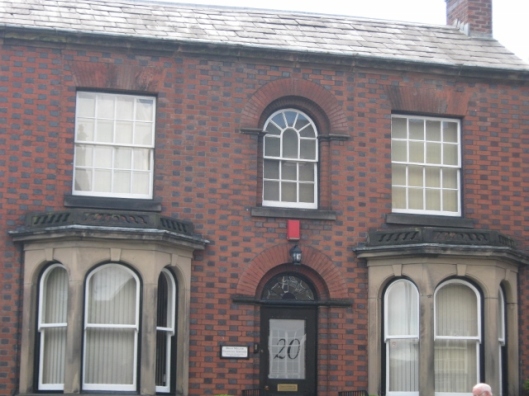
I love this house with its chequered brickwork and the arch over the door mirrored by the arch over the window above it.
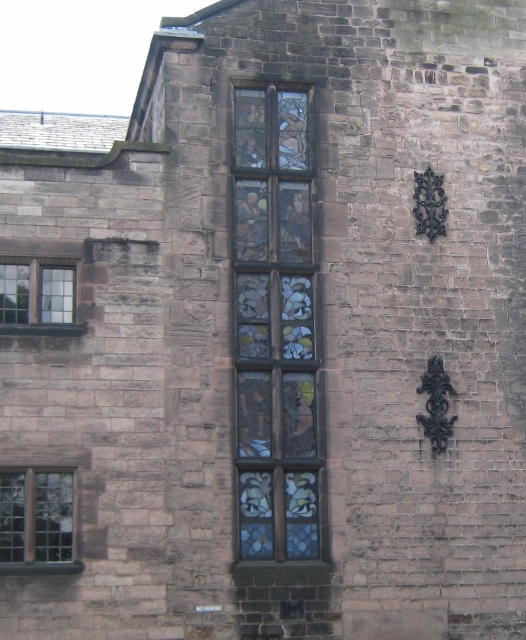
I wonder if this window is where the stairs are. How lovely to have jewel-coloured light shining into your home! The next time we go to Leek I must try to find out more about this house.
We began to feel hungry and went to the White Hart Tea Room in order that we might sample their wonderful Staffordshire oatcakes.
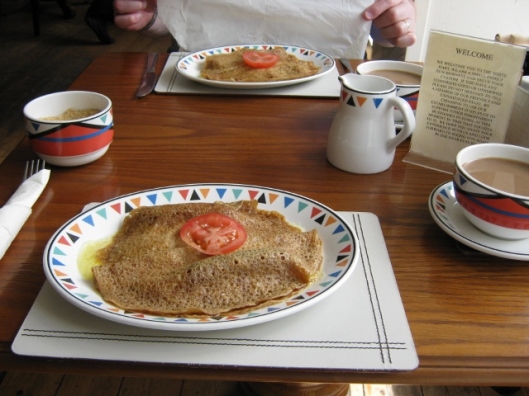
These oatcakes are made like pancakes but with oat-flour instead of wheat-flour. They are like the galettes you get in Brittany, France (which are made with buckwheat!)
Mine was filled with sausage and melted cheese and R’s had bacon and melted cheese.
Rested and refreshed, R and I continued to wander about the town.
There is an 8th Century Saxon cross in the churchyard and some of the stained glass in the church is by Morris and Co. The church also has a wonderful collection of examples of the work of the Leek School of Embroidery that R and I were lucky enough to see a couple of years ago in an exhibition. There were enormous altar frontals and embroidered panels as well as smaller pieces of work and all so beautifully done. The church was extended in the 19th Century by the architect George Edmund Street. William Morris was one of his apprentices.
Apparently, until the trees in the churchyard grew too tall, a phenomenon called a double sunset could be seen from this church at about the time of the summer solstice. There is a hill called the Cloud and as the sun sets it can be seen above and to the side of the hill at the same time.
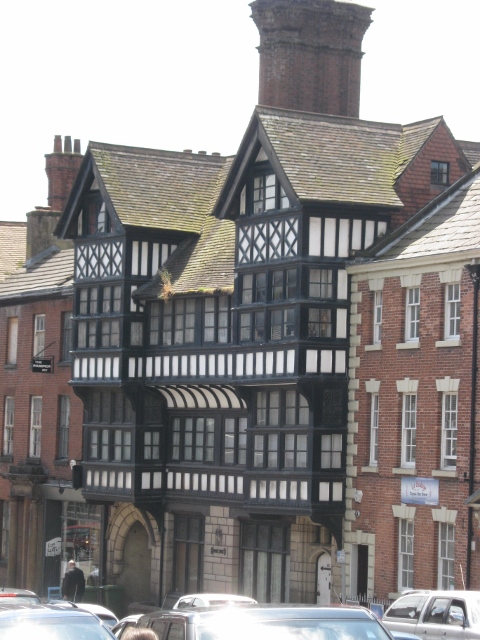
Spout Hall. A mock Tudor building constructed in 1873 and attributed to the architect Richard Norman Shaw. Look at the size of the chimney! The gutters also need clearing!
The plaque on the wall states that the building was restored in 1911. It also says ‘The gift of Elizabeth Ash widow, the eldest daughter of William Jolliffe, Esqr. Anno Dom 1696’
I looked on the British History Online website and discovered that William Jolliffe acquired some land (part of an estate) in 1644. When he died in 1669 the land passed to his daughter Elizabeth Ashe (the site spells her surname with an ‘e’), widow of Edward Ashe a London draper. In 1677 she charged the land with rent to support the almshouses which she had founded at Leek.
I wonder what the tenant of the land thought about that!
Looking at the building it appeared to be disused and was a little worse for wear.
Ragged Schools ‘were charitable organisations dedicated to the free education of destitute children in 19th Century Britain.’ (Wikipedia) Eventually these schools began opening at night as well to educate all comers, children and adults. The novelist Charles Dickens began his association with Ragged Schools in 1843 when he visited one in London. He was appalled by the conditions but wished to help them. His experience inspired him to write ‘A Christmas Carol’. He said, ‘They who are too ragged, wretched, filthy and forlorn to enter any other place: who could gain admission into no charity school, and who would be driven from any church door: are invited to come in here, and find some people not depraved, willing to teach them something and show them some sympathy.’
William Sugden the architect arrived in Leek in 1849 to work on the design of the Churnet Valley Railway. His son Larner was born in 1850 and was apprenticed to his father in 1866. Both men’s influence on the town was very great. It was they who built the Methodist Chapel and Ragged School in 1870. Larner’s masterpiece was the Nicholson Institute built in Queen Anne style in 1882.
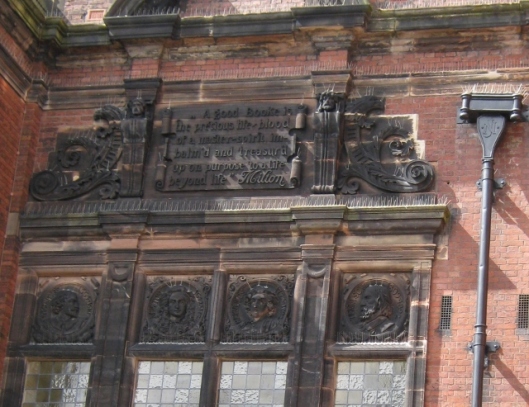
Larner incorporated busts of Shakespeare, Newton, Reynolds and Tennyson into the building, representing 400 years of artistic and scientific achievement from the 16th to 19th Centuries.
The quote from Milton says, ‘A good booke is the precious life-blood of a master-spirit imbalm’d and treasur’d up on purpose to a life beyond life.’
The Institute is tucked away behind a 17th Century building on the main road. Any other architect of the time would have pulled the building down but apparently Larner had a real regard for old buildings and so the building was allowed to remain.
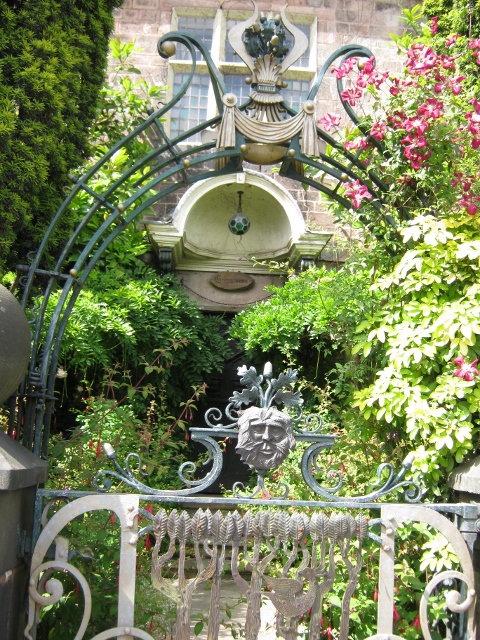
And here it is. Or at least a part of it. There were so many trees and plants in the front garden that I couldn’t see much of the house.
Local rumour has it that William Morris founded the Society for the Protection of Ancient Buildings in 1877 as a result of his successful campaign to prevent the demolition of this building. It was through the SPAB he came into contact with Larner Sugden who went on to publish some of Morris’ speeches and essays!

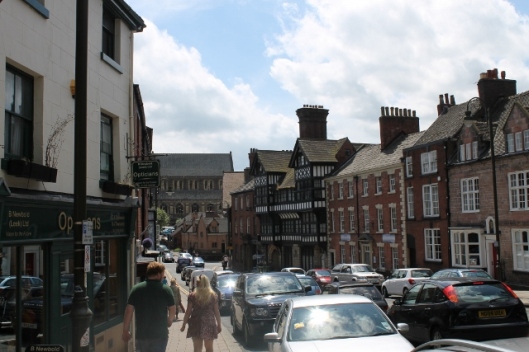
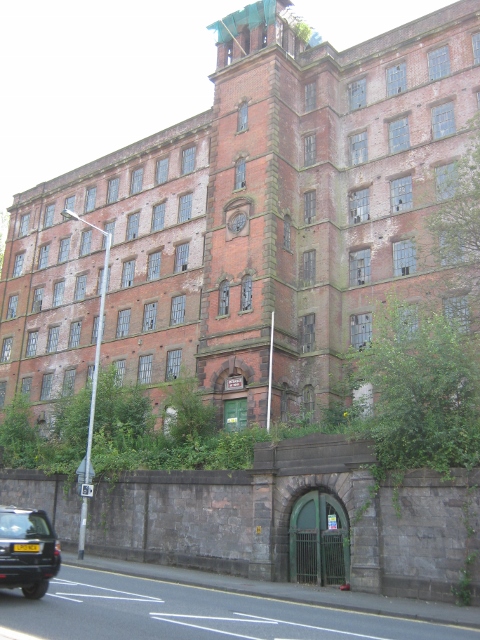
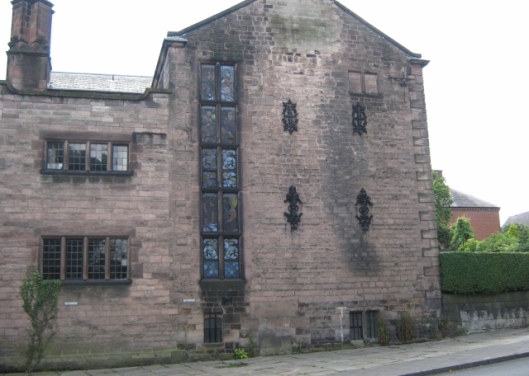

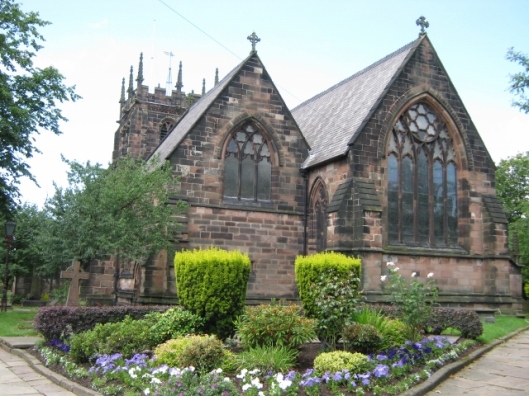


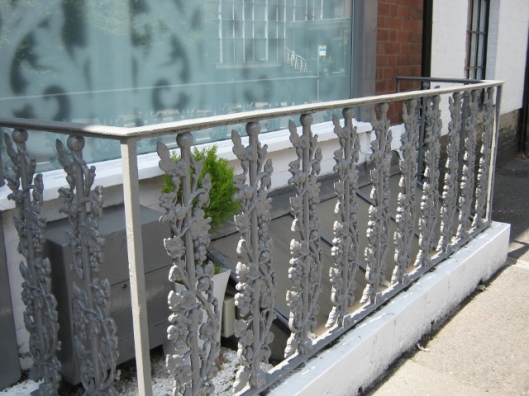
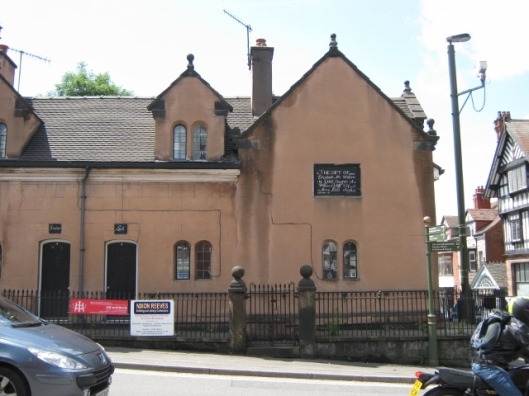


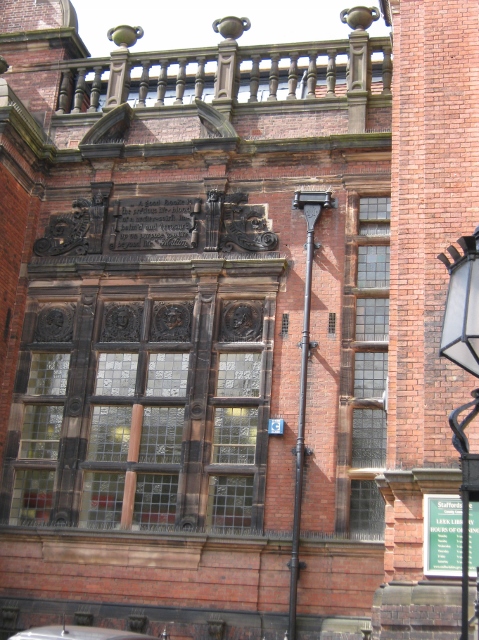


The Staffordshire oatcakes look like a treat.
LikeLike
They are very tasty and extremely filling.
LikeLike
There are certainly some beautiful buildings there, and I can see why you went. the house with the two colored brick almost looks like it was woven.
I’m surprised they haven’t turned the old mills into housing or retail like they’ve done here. Most of ours have survived by being re-purposed.
I’ve never heard of a ragged school but I’m all for them and I’m glad to hear that there are such places in the world. Mr. Dickens was apparently a very kind hearted soul.
A very interesting tour. Thank you.
LikeLike
I too am surprised that the mill hasn’t been turned into something else. I am sure it will some day as the building is quite something. The attention to detail is very great even on such a utilitarian structure. Dickens cared very deeply about many things and all of his novels highlighted some failing in the 19th century system. By the end of the 19th century Ragged Schools weren’t needed any more as other better schemes were then in place. Fortunately for us we now have compulsory free education for all until the age of 17 and free health care too. All because of philanthropic people like Dickens.
LikeLike
Lots of interesting architecture, ironwork, and other things in this post, but what I like most is the way that you connected history to people whom I have read about and to the place where it all came together! You’ve added a lot of context with your research, thank you!
LikeLiked by 1 person
Thank-you Jerry. I knew about the Morris/Leek connection as I have been interested in him and his work for many years. It was only when I really researched the buildings and architects that I discovered all the other connections. My husband is a rail and train enthusiast so we have known about Sugden and the Churnet Valley Railway and visited that a while ago. I was so surprised myself at the links between that and Morris!
LikeLike
Clare, this is one of your most intriguing posts.
Such interesting places and your photos do them credit. I have more questions:
1: Can that abandoned mill building be put to another use? Seems a shame to leave it abandoned.
2: A dare: Ya gotta go back one day and get yourself inside that house with the long stained glass window! I, too, wonder what the inside looks like, especially with the sun pouring through that glass.
3: What an interesting gate inside the Larner house. Can you talk your way into that one too? Would love to see the gardens.
4: St. Edward church – what a beauty. Did you get inside?
OK, I’ll stop there. As I said, intriguing. Well done.
LikeLike
Thank-you, Cynthia. Questions and a challenge! I’ll see what I can do.
1: I am sure that something will be done with the mill. Most of these type of structures are turned into something else but it costs money which many people don’t have a lot of at the present. This particular mill has been made safe and it looks as though it won’t be demolished. It is so well built. As I said to Allen, the attention to detail is fantastic – care was taken even for mills and factories in the 19th century.
2: I will see what I can do about this. We visit the town at least once each time we stay in the Peak District so I hope to get a lot more info next spring/summer.
3: Ditto. It’s a pity it’s no longer a tea-shop as that is the best way to see an interesting building. Eat cake, drink tea/coffee, sit in pleasant room or in the garden on a fine day then wander about ‘snooping’ looking for the ‘Ladies Room’.
4: We didn’t go into the church this year but we have been in there before as that was where we saw their exhibition of exquisite needlework. It is a lovely church and I hope to do a post about it the next time we go. As you will see in my next Peak post we visited another church that day and also a restored water mill. I have learnt not to put too much into one post!
LikeLiked by 1 person
fascinating post. We have the william morris gallery in nearby walthamstow – I havn’t been yet – isn’t that often the way that the places on your doorstep you rarely get time to visit?
I love oatcakes. I will have to see if any local supermarkets stock them (I don’t hold out much hope!)
LikeLiked by 1 person
Thank-you, Rachel. I know exactly what you mean! I used to live just a few miles from Chislehurst Caves and never once went there! There were so many places in London I should have visited when I lived in the suburbs but didn’t.
I have only seen oatcakes in the supermarkets in Staffordshire. I expect they can be ordered on-line. My mother tried making them for my father as he had been evacuated during the war to Tunstall near Stoke-on-Trent and had been given them to eat there and had loved them. He didn’t think much of my mother’s attempts!
LikeLike
Excellent gallery dear Clare… I truly enjoyed the tour… Stunning!.
Thanks for sharing and all the very best to you. Aquileana 😛
LikeLike
Thank-you, Aquileana! Your comments are always so generous. Clare xx
LikeLiked by 1 person
My maternal grandparents grew up and live in Staffordshire, I have an Aunt who lives in Leek. Great photographs. I like my oatcakes hot with Cheshire cheese, crispy bacon rolled up in a tube shape and tomato ketchup on the side or baked beans. You can eat them cold too with butter and raisins or sultanas rolled into them 😊.
LikeLiked by 1 person
Oooh Charlotte! That sounds yummy. I must try that.
LikeLiked by 1 person
Pingback: A Walk on Ramshaw Rocks – Peak District Holiday | A Suffolk Lane